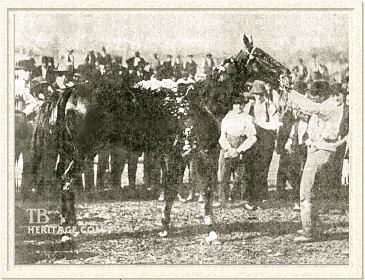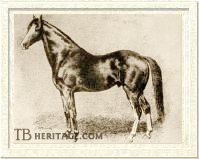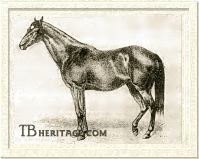|
|
Yo Tambien

|
|
 |
|
|
Yo Tambien was America's Queen of the Turf of the gay '90s. The bright chestnut filly came blazing out of California as a two year old, and stomped the competition in the midwest and east for four seasons, chalking up 44 wins in 73 career starts, unplaced only nine times. A product of a cross between the brilliantly fast California-bred Joe Hooker and the great broodmare Marian, she was the winningest, longest racing, and most adored of all her dam's outstanding children, and the best offspring of her sire.
She was bred by Theodore Winters, the owner of Lexington's great son, Norfolk, and breeder of the brilliant Emperor of Norfolk, who was half-brother to Yo Tambien. Winters, James Ben Ali Haggin, and Lucky Baldwin, were the most influential of extremely successful late nineteenth century California breeders whose efforts brought the state into national prominence in the racing world, only to subside after the turn of the century with the crippling blow of anti-betting legislation that sent the west coast breeding and racing industry into a tailspin.
|

Joe Hooker

Marian
| |
Her sire, the gaudily-marked chestnut Joe Hooker (1872, by Monday), was a tail-male descendant of Lexington. He had a troubled and brief racing career, although California turf writer Thomas Merry said he would "die in the belief that he [Joe Hooker] was the fastest horse ever saddled on a California track..." After Winters purchased him, he was bred to a few mares at Winters' Rancho del Arroyo, near the present town of Winters, California, and then sent to the Winters ranch in Nevada, Rancho del Sierras, where he was turned loose to run with some mares. When three of the five foals from his first Rancho del Arroyo-bred crop started to win, Winters had Joe Hooker retrieved from Nevada and put in the stud at his recently-established Rancho del Rio farm south of Sacramento, where the aging Norfolk and the rest of Winters' breeding stock had been transferred. He sired some good national runners, including American Derby winner C.H. Todd and his brother, the top juvenile Sorrento, and many successful racehorses in California.
Marian (named "Marion," but changed by the ASB) was brought west from Illinois in 1874 by her breeder, Joseph Cairn Simpson, an editor and co-owner of Turf, Field and Farm, in New York, and an associate of S.D. Bruce in the compilation of the American Stud Book. In California Simpson organized the Pacific Coast Blood Horse Association, and became a founding member of the National Trotting Association; from the west, he was a regular contributor to turf publications throughout the U.S.
|
Purchased by Winters, Marian was first put to Norfolk in 1876, and produced a bay filly the following year that was sold to Oregon, and vanished into the mists. Her next nine foals were also by Norfolk, a "nick" that produced his best offspring. When she failed to the cover of the aging Norfolk (he died in 1890), she was put to Joe Hooker in 1888, and the red filly dropped the following year at Rancho de Rio was Yo Tambien. Of Marion's fourteen foals, eleven were stakes winners, one died early at age two, and two did not race. Of her winners, the best by Norfolk were the high-class Duchess of Norfolk, a big winner in California who in the east won an allowance race in Chicago and the Handicap Sweepstakes in New York; Emperor of Norfolk, one of the top racehorses of the late nineteenth century; the speedy, unbeaten The Czar, who won the top races for three-year-olds in California before dying enroute to his eastern engagements; the unbeaten juvenile El Rio Rey (Hyde Park Stakes at Washington Park, Chicago, and the Great Eclipse Stakes in New York, among his seven starts, during the course of which he defeated every great juvenile in the U.S.). When bred to Joe Hooker, in addition to Yo Tambien (in Spanish, "Me, too"), she produced Yo El Rey, a successful runner in California, Rey Del Sierras, and Vera Reina, her last foal.
The most appropriately named filly, Yo Tambien, then, came from a mare who had produced a stellar succession of winners, and of them all, it was she who ran longest and won more than any of her other illustrious half-siblings, including Emperor of Norfolk. She started as a juvenile for Winters in San Francisco, winning her first five furlong race by defeating five other fillies, and followed that by winning the Youthful Stakes, also at San Francisco's Bay District course. Winters wasted no time shipping her east to run; by the end of her first season, she had won the Lakeview Handicap at Washington Park, Chicago and five other races -- four in succession at Garfield Park -- and placed second to Carlsbad, later an American Derby winner, in the Minneapolis Stakes. Her total for the year was eight wins in fourteen starts, and some of those defeats were attributed to her fretful nature at that age, where she exhausted herself before the start.
Winters, who had decided to withdraw from the racing end of the business and devote his attention to breeding at his Nevada ranch, shipped some of his youngsters to the Crescent City Jockey Club in Chicago for dispersal, where racehorse owner and gambler Chris Smith purchased the entire group, including Yo Tambien, who was sold for $17,000. She ran for his Kendall Stables for the rest of her career.
At age three she won fourteen of her sixteen starts, and in the process, made such a mark on race goers and turf observers, that she was justly dubbed Queen of the Turf. Of her races that year, her two most impressive were the 1 - 1/4 mile Garfield Park Derby and the Great Western Handicap. In the former, she was weighted with 127 pounds, and was the only filly, up against the best colts of the west, including Kentucky Derby winner Azra (who shared high weight with her), the St. Louis Club Memorial Handicap winner Wadsworth (122 pounds), and the triple threat of Edward Corrigan's stable -- Huron, Lew Weir, and Cicero. In addition, the track was a heavy, muddy mess, after a month's worth of rain. She was sent to the front at the start of the race, and hung on to win by half a length, with Wadworth second and Azra one-and-one-half lengths behind in third...it was, a Chicago turf writer said, "in many respects...one of the most remarkable races ever run in the West."
In the 1-1/2 mile Great Western Handicap, she "Paraded in front of the stand...loudly applauded, particularly as she turned her head gracefully toward the crowd as she cantered slowly by on her way to the post. She was not at all nervous or excited, and Thorpe cantered slowly to the post, riding as easily and slowly as if he were on a park saddle horse." In this race, she broke second and ran to the front at a blistering speed, and when challenged by Joe Blackburn one furlong from the wire, her jockey gave her a shake, and she "drew away from Joe Blackburn as if it were the first quarter of the race instead of the end of a long mile and a half," winning by two lengths. Her time over that race was 2:33-3/4, giving away tons of weight to every other horse in the race. After her win in the Great Western, Smith was offered $35,000 for her, but he turned it down, saying, "I refuse absolutely to place a value on the filly." Her other wins that season included the Tobacco Stakes at Latonia, the Twin City Derby at St. Paul, Minnesota, and the Boulevard, Stakes and Drexel Stakes at Garfield, and a purse race there in which she established a record over 1-1/16 miles in 1:45-1/2. Taken to New York, she was knocked into a fence early in the running of the Bridge Handicap at Coney Island, and was eased up, but finished the season with a win in October in Nashville, Tennessee.
At age four she was placed in all her seventeen races, winning eleven times and four times second. Her most impressive wins that year included a $1,000 purse over a mile at Washington Park, in which she defeated the great California-bred colt Racine, and an eight-race winning streak, which included defeating Ida Pickwick (112 pounds to Yo Tambien's 124) in the Merchants' Stakes at Latonia, the Cincinnati Hotel Handicap, and a $1,000 match race against Hawthorne at Hawthorne Park, Chicago. The next year, 1894, she won ten of her eighteen races, including the St. Louis Brewers' Stakes, the Foster Memorial Handicap at Washington Park, and the Spencer Handicap at Saratoga. At age six, in 1895, this heavily-used mare won just one of her nine starts, a purse at Latonia. Her career earnings were $89,480, the third highest earnings by a mare in American history (first was Miss Woodford at $118,270, and second Firenzi at $112,586).
In 1896 Yo Tambien was sent to Milton Young's McGrathiana Stud in Kentucky to be bred to the great racehorse Hanover, who had topped the sire's list for the first time in Yo Tambien's last year of racing. This meeting of best-to-the-best, however, was not to be. While in turn-out, she was impaled on a loose board in her paddock and sustained such a serious injury that she had to be destroyed, an abrupt ending to a short and brilliant life.
--Patricia Erigero
|
|
|
|

